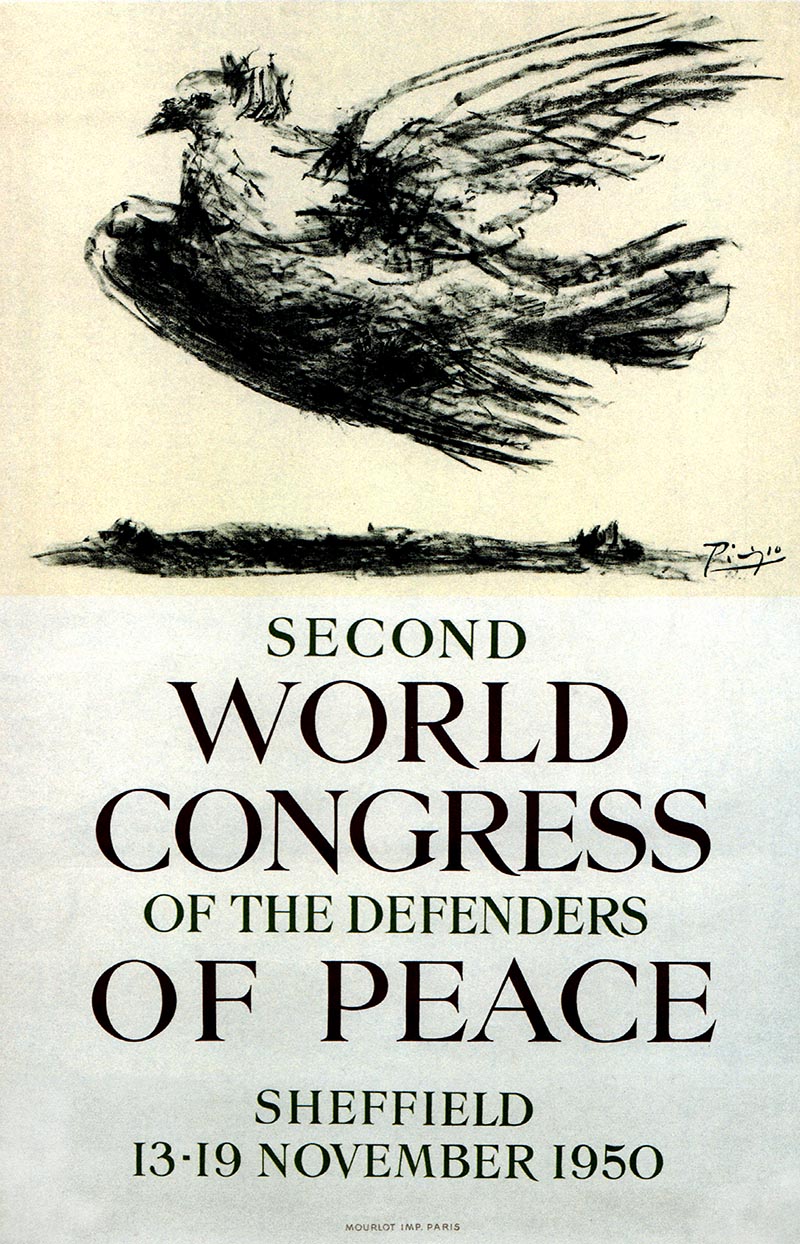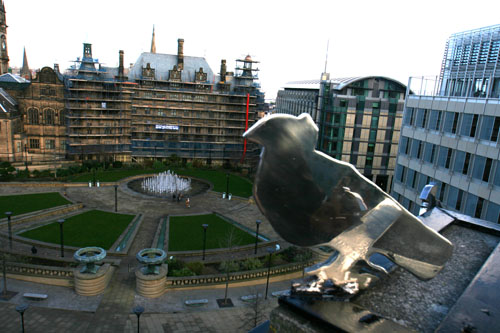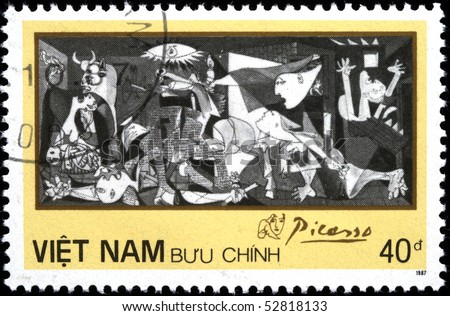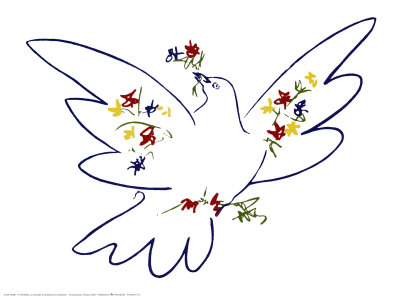

Peace Art of Pablo Picasso [1881-1973]
Right click image to enlarge.

1937 - Plaque, rue des Grands-Augustins, Paris (France).



1937 - Guernica, Museo Nacional Centro de Arte Reina Sofía (MNCARS), Madrid (Spain). Painted by Pablo Picasso [1881-1973]. Commisisoned by the government of Spain for the Paris International Exposition. "A primal expression of sorrow, anguish and torment, the tapestry’s fragmented symbols are woven in dull tones of brown, cream and black – the colour of the rubble of the Basque city of Guernica, razed to the ground in history’s first example of the saturation bombing of a civilian population. It is a graphic depiction of the impact of war – specifically aerial bombardment – on innocent bystanders." First went on show at the Whitechapel Gallery in London in 1939, after it had been exhibited in Paris. "Picasso let two Parisian weavers make three exact copies of the picture after realising his original was too fragile to be taken around the world." (Where are they now?) One full sized copy is at the United Nations in New York City.

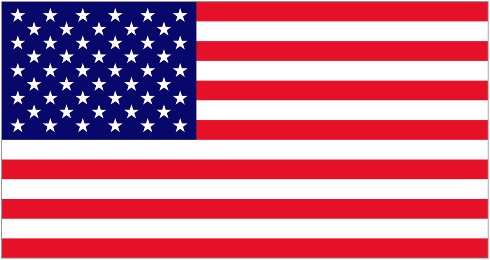
1944-45 - "The Charnel House," Museum of Modern Art (MOMA), New York City, New York (USA). Oil and charcoal on canvas. "The Charnel House as an anti-war statement has always been overshadowed by and compared (unfavourably) to its massive cousin Guernica (1937); and partly because unfinished works by artists of any standing are generally deemed to be less important than finished ones..."


April 20-23, 1949 - Congres Mondial de la Paix / World Congress of Peace, poster by Pablo Picasso [1881-1973], Paris (France). Picasso drew many doves of peace during this period.
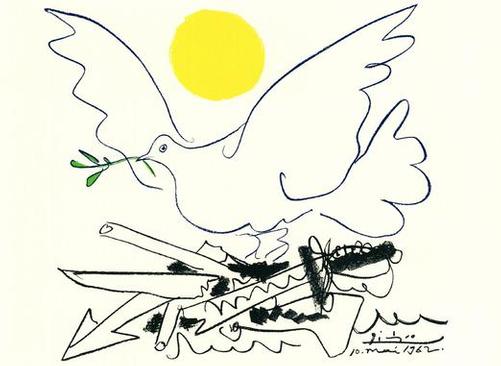
Circa 1949? - "World Without Weapons." Also called "Blue Dove with Yellow Sun" by Pablo Picasso [1881-1973]. Lithograph 30 x 22 inches. Where is the original? What's its date? (I've seen circa 1949 and 1957.)

November 13-19, 1950 - Second World Peace Conference, Sheffield (England). Poster by Pablo Picasso [1881-1973] says "Second World Conference of the Defenders of Peace." Picasso is the only international intellectual allowed into the UK by the Labour government for this conference, and he consequently refuses to attend. "The World Peace Congress (WPC) emerged from a Communist-led peace congress held at Wroclaw (Poland) in 1948. A subsequent congress in Paris & Prague in 1949 set up a World Committee of Partisans for Peace, and a congress in Sheffield & Warsaw in 1950 reconstituted the Partisans as the World Peace Council (WPC)."
D O V E
October 10, 1952 - Colombe Volant / Flying Dove. "This work is hand signed by Pablo Picasso (Malaga, 1881 - Mougins, 1973) in pencil in the lower right margin. The plate has also been signed and dated in the lower right. This work is numbered from the edition of 200 in lower left."

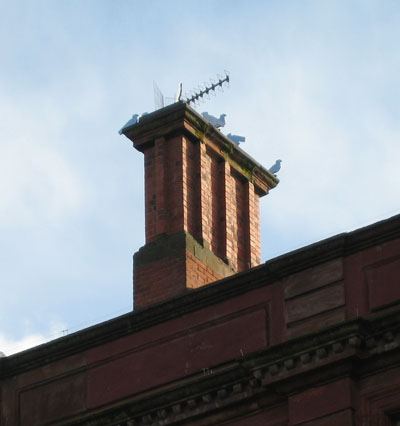
D O V E S 
February 1, 2012? - Peace Doves, opposite Peace Gardens, St. Paul's Parade, Sheffield (England). "Stainless steel sculpture by Sheffield artist Richard Bartle. Features seven life-size doves perched on chimney of Bar Ha!Ha! (now Browns Bar & Brasserie) next to the Peace Gardens. Inspired by Pablo Picasso’s visit to the Second World Peace Congress held in Sheffield in 1950. Pablo Picasso [1881-1973] arrived at Sheffield Midland railway station carrying a bouquet of chrysanthemums & wearing an old raincoat & blue beret. He was welcomed by members of the local communist party, the press & the public, and taken on a tour of the city. He ate a bacon sandwich at Thorpe's cafe in Fargate; had his hair trimmed at Peckitt's barbers, and drew a 'dove of peace' on a napkin in Butler’s Dining Rooms. The Congress was to be a special debate on the Korean War, but the Government at the time refused to allow important speakers into the country, & it was abandoned. Picasso gave a short speech, recalling that he had learnt to paint doves from his father, and ending by saying 'I stand for life against death; I stand for peace against war.' Later whilst returning to London he drew another Dove of Peace on a napkin, which he gave to the bodyguard who had accompanied him around the city. This drawing is now part of Sheffield Galleries & Museums Trust’s collection and is now on permanent display at Weston Park Museum. Richard Bartle has used the original poster [from 1949], designed by Picasso, as a template to create the sculpture, in celebration of the memory of Picasso and the cause of peace that he introduced into an already radically thinking Sheffield..."

1951 - Massacre en Corée / Massacre in Korea, Musée National Picasso / National Picasso Museum, Paris (France). Depicts a massacre of Korean civilians by US forces at No Gun Ri from 26-29 July 1950, which has remained controversial to this day. Click here for a description. Based on "The Third of May 1808" by Francisco Goya (right image). "During this period, Picasso is believed to have been moving away from his earlier communist ideology. Alongside with Guernica, The Charnel House (1944-45), War and Peace (1952), and Rape of the Sabine Women (1962–63) this is one of Picasso's works that he composed to depicts the politics of his time. At 43 inches (1.1 m) by 82 inches (2.1 m), the work is smaller than his Guernica. However, it bears a conceptional resemblance to that painting as well as an expressive vehemence."
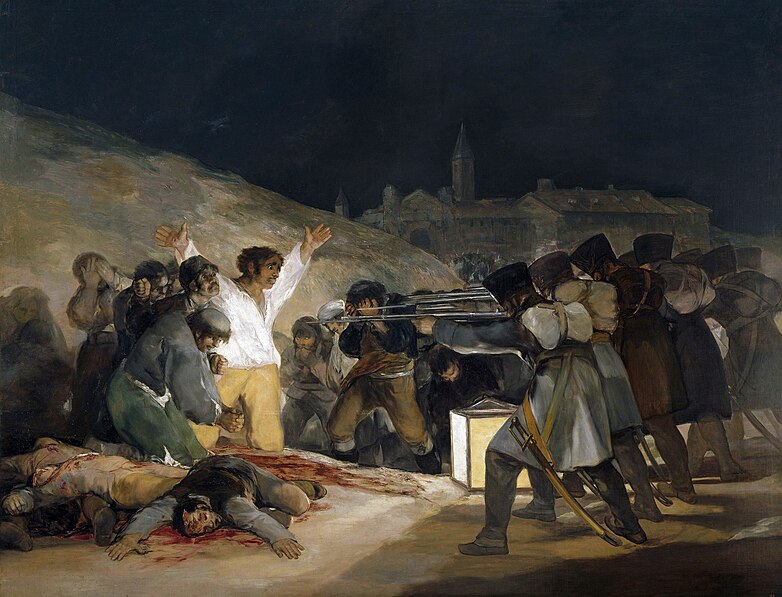

August 1951 - Scarf to commemorate the 3rd World Festival of Youth & Students for Peace (WFYS), East Berlin (East Germany). Attended by 26,000 participants from 104 countries. Its motto was: "For Peace and Friendship - Against Nuclear Weapons." /// Image shows scarf to commemorate the festival by Pablo Picasso [1881-1973]. "During the late 1940's and early 1950's, Picasso was actively involved in the communist-supported International Peace Movement and attended congresses in Poland, Italy & England. In 1950 he was awarded the Lenin Peace Prize, but his art was not generally approved by the Communist Party. Picasso avoided using overtly communist symbolism in his work and refused to work in the socialist realist style favoured by the party."


1952 - World Peace Congress , East Berlin (East Germany). Image shows Picasso's dove above the stage.


1955 - "Guernica," UN Headquarters, New York City, New York (USA). Full-sized tapistry version of original commisisoned by the government of Spain for the Paris International Exposition and painted in 1937 by Pablo Picasso [1881-1973]. "Commissioned in 1955 by Nelson Rockefeller, and placed on loan to the United Nations by the Rockefeller estate in 1985. Less monochromatic than the original, and uses several shades of brown... On 17 March 2009, Deputy Spokesperson for the Secretary-General Marie Okabe announced that the Guernica tapestry had been moved to a gallery in London in advance of extensive renovations at UN Headquarters. The Guernica tapestry is the showcase piece for the grand reopening of the Whitechapel Gallery. It is located in the 'Guernica room' which was originally part of the old Whitechapel Library."

Date? - Friedenstaube / Dove of Peace, Rathausstraße / City Hall Street, Nikolaivierte / Nikolai Quarter, East Berlin (Germany). Near Berliner Fernsehturm / Berlin TV Tower. Sign on apartment building reads "Berlin - Stadt des Friedens / Berlin - City of Peace." Emblem is peace dove as drawn by Picasso. "By Gerhard Thieme. Given to the eastern part of Berlin by the (socialist) World Council."

1981 - Postage stamp (Spain). Depicts "Guernica" painted by Pablo Picasso in 1937 (qv).
Date? - Postage stamp (Viet Nam). Depicts "Guernica" painted by Pablo Picasso in 1937 (qv).



February 5, 2003 - "Guernica," UN Headquarters, New York City, New York (USA). "A large blue curtain was placed to cover this work, so that it would not be visible in the background when Colin Powell and John Negroponte gave press conferences at the United Nations. On the following day, it was claimed that the curtain was placed there at the request of television news crews, who had complained that the wild lines and screaming figures made for a bad backdrop, and that a horse's hindquarters appeared just above the faces of any speakers. Some diplomats, however, in talks with journalists claimed that the Bush Administration pressured UN officials to cover the tapestry, rather than have it in the background while Powell or other U.S. diplomats argued for war on Iraq. According to The Washington Times in 2003, the sequence was as follows: * 2003, Monday 27 January: Guernica found covered by journalists with a baby-blue banner and an UN-logo. "It's only temporary. We're only doing this until the cameras leave," said UN-spokesperson Abdellatif Kabbaj. He clarified: "We had a problem with, you know, the horse" (that is, in the background of a camera-shoot). * The drapes were installed Monday, 27 January and Wednesday, 29 January only. Other days of the week, including Tuesday in between, there was no drape. On these other days the UN-Security Council's agenda included Afghanistan, Western Sahara and Lebanon."
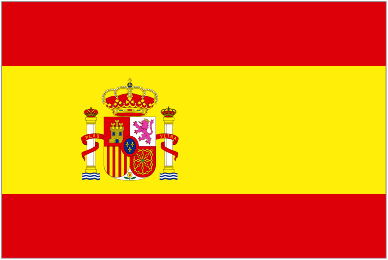
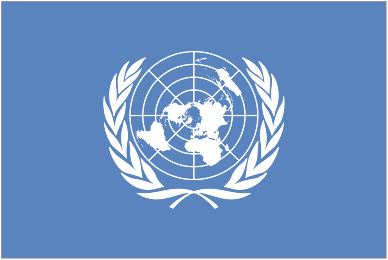


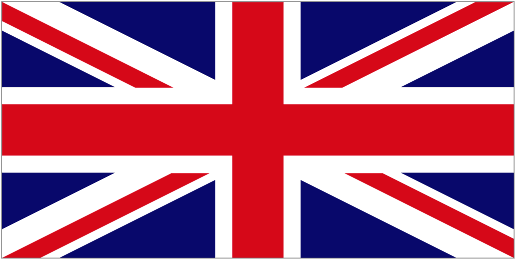
April 2009 - "Guernica," Whitechapel Art Gallery, London (England). "In April, Picasso’s controversial Guernica returned once again to the Whitechapel Gallery in East London. This time however the piece is a tapestry copy of the genuine article, commissioned in 1955 by Rockefeller, and, since the 1980's, permanently displayed at the UN Security Council in New York... Goshka Macuga, the artist behind the exhibition, brings Guernica into its modern context by setting it alongside symbols of the UN’s failure to stand up to pressure from the USA and UK about the necessity to invade Iraq. The space is lined with the kind of corporate upholstery you find in UN boardrooms: a light blue carpet and a polished, round mahogany table in the centre of the room. A bust of Colin Powell (lower image), based on a famous photo taken of him as he brandished a test tube while making his case for the invasion of Iraq, rises from a pile of rubble. Minutes after he made this speech, Guernica became the centre of another controversy as journalists discovered it had been covered up by a blue curtain during the subsequent press conference. The excuse officials made was that the weave of the tapestry would interfere with the cameras. I found looking Powell in the face in the presence of Guernica a powerful and unsettling experience."



August 21, 2009 - "Guernica," Falls Road, Belfast (Northern Ireland). "Gasta.com [a UK search engine] contnues to support community artists in Belfast with a revitalization of the Art forPeace mural of Guernica in the Falls road area of Belfast near Bombay street where the troubles started in 1969. The Mural was painted by Danny Devenny with a host of other artists including Mark Irvine, Robert Ballagh, Doc from Derry & many international visitors. The Mural was unvielled by Gerry Adams & the wife of the late David Irvine [1953-2007], mother of artist Mark. Both Mark & Danny then moved over to Liverpool & painted the famous John Lennon mural project." /// Right image shows "muralists Danny Devenny, former Irish Republican Army (IRA) prisoner, & Mark Ervine, son of David Ervine, former Progressive Unionist Party leader & Ulster Volunteer Force (UVF) member, both of Belfast, [before] work[ing] with University of Massachusetts community members to create a massive mural for the campus." Information courtesy of Prof. Lee A. Smithey.

Date? - What?, where? "i thought that the contrast between american children's innocence as expressed in their sunny trusting smiles and picasso's masterpiece mural 'guernica' full of suffering and protest would express the dichotomy between what could be and expected and what was and could be expected due to wars."



B
O
O
K2010 - "Against the Wall: The Art of Resistance in Palestine" by author & photographer William Parry, PlutoPress, London, pp. 192, 100 NIS. About peace graffiti on the Palestinian side of the Israeli apartheid wall, including parody of Guernica (right image) by Ron English (who wrote the forward). Click here to see selected images from the book.


May 21-August 30, 2010 - Picasso: Peace and Freedom, Tate Gallery, Liverpool (England). "More than 150 anti-war paintings & drawings by Picasso. While not including Guernica, these works reveal the artist as a passionate peace activist. Picasso, a Communist party member, adopted a disarmingly simple image of a dove as a universal symbol of hope during the cold war. But, given his taste for cubist fragmentation, it is in images of violence against innocents that Picasso best makes his protest. The human wastage in The Charnel House, for instance, is so distorted it barely looks like a figurative image at all. Yet it is far from an abstraction. This is art that unflinchingly dares to tackle the tragic grotesqueries of modern day warfare." /// This exhibition has been curated by Tate Liverpool, with the Albertina acting as a co-organizer." /// Image shows "Still Life with Skull, Leeks and Pitcher."


D O V E S 
February 1, 2012? - Peace Doves, opposite Peace Gardens, St. Paul's Parade, Sheffield (England). "Stainless steel sculpture by Sheffield artist Richard Bartle. Features seven life-size doves perched on chimney of Bar Ha!Ha! (now Browns Bar & Brasserie) next to the Peace Gardens. Inspired by Pablo Picasso’s visit to the Second World Peace Congress held in Sheffield in 1950. Pablo Picasso [1881-1973] arrived at Sheffield Midland railway station carrying a bouquet of chrysanthemums & wearing an old raincoat & blue beret. He was welcomed by members of the local communist party, the press & the public, and taken on a tour of the city. He ate a bacon sandwich at Thorpe's cafe in Fargate; had his hair trimmed at Peckitt's barbers, and drew a 'dove of peace' on a napkin in Butler’s Dining Rooms. The Congress was to be a special debate on the Korean War, but the Government at the time refused to allow important speakers into the country, & it was abandoned. Picasso gave a short speech, recalling that he had learnt to paint doves from his father, and ending by saying 'I stand for life against death; I stand for peace against war.' Later whilst returning to London he drew another Dove of Peace on a napkin, which he gave to the bodyguard who had accompanied him around the city. This drawing is now part of Sheffield Galleries & Museums Trust’s collection and is now on permanent display at Weston Park Museum. Richard Bartle has used the original poster [from 1949], designed by Picasso, as a template to create the sculpture, in celebration of the memory of Picasso and the cause of peace that he introduced into an already radically thinking Sheffield..."
